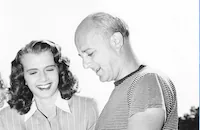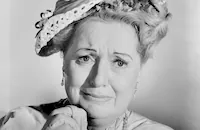Condemned Women

Brief Synopsis
Cast & Crew
Lew Landers
Sally Eilers
Louis Hayward
Anne Shirley
Esther Dale
Lee Patrick
Film Details
Technical Specs

Synopsis
While serving a three-year sentence for larceny, Linda Wilson, a former nurse, meets Dr. Phillip Duncan, a young physician who is conducting physiological experiments at the women's prison. In spite of Linda's embittered attitudes, Phillip encourages her to work as a nurse at the prison hospital and, after battling a prison typhoid epidemic with her, realizes he has fallen in love with her. Bolstered by Phillip's love, Linda, who was forced to steal food after she was unfairly fired from a nursing position, refuses to participate in an upcoming prison break that has been set up by Anna "Big Annie" Barry, her vicious, scheming cellmate. When, however, Warden Edmund Miller, who has found out about Phillip's relationship with Linda through the vindictive head matron, Mrs. Clara Glover, admonishes her to end the affair to protect Phillip's career, Linda decides to join Annie and escape. After Linda steals a set of master keys from the hospital, she and Annie overcome a matron, break a boiler pipe and start a fire panic in the cell blocks. In the ensuing chaos, a matron shoots and kills young Millie Anson, Linda's other cellmate who had taken the blame for a theft committed by her boyfriend, and wounds Annie before being shot fatally herself. Linda and Annie then force Mrs. Glover to drive them to safety outside of the prison. After leaving Mrs. Glover by the roadside, Annie dies from her wounds and Linda remains at large. Eventually Linda is trapped by the police and is put on trial for the escape. Although faced with a life sentence, Linda refuses to defend herself against charges that she led the escape and killed the matron. Finally Phillip asks the judge to allow him to question Warden Miller, who confesses that he told Linda to remain silent to protect Phillip. Cleared of all serious charges, Linda accepts Phillip's marriage proposal and faces her final months of imprisonment with hope and courage.

Director

Lew Landers
Cast

Sally Eilers

Louis Hayward

Anne Shirley
Esther Dale

Lee Patrick
Leona Roberts

George Irving
Richard Bond
Netta Packer
Rita Laroy
Florence Lake

Jack Carson
Kathryn Sheldon
Vivien Oakland
Edythe Elliott
Crew

Film Details
Technical Specs

Articles
Condemned Women
Here, the prisoner (a former nurse) is portrayed by Sally Eilers, in stir on a shoplifting charge, and the prison doctor is played by Louis Hayward. Their love helps to reform her, but the rest of the prison population includes some rough cookies--especially a schemer played by Lee Patrick who organizes a breakout, leading to disillusionment, chaos and murder.
The film was received as a speedy, exciting little melodrama in 1938, with The Hollywood Reporter declaring, "There is a vitality and freshness to this minor prison play that lifts it out of the rut, galvanizes it with pulsing life, and gives it a powerful tug on the emotions." Sally Eilers drew particular attention, with critics noting her "fine conviction and quiet intensity" and calling her performance "skillfully modulated and evolved." Eilers, whose real name was Dorothea Sally Eilers, had become a star with her sensational turn in Bad Girl in 1931, and she remains a strong fan favorite today among classic movie fans.
Louis Hayward, born in South Africa but raised in London, had recently made a strong impression in Anthony Adverse (1936) and would soon score a big hit in The Man in the Iron Mask (1939). A few months after the release of Condemned Women, he married actress Ida Lupino.
Also in this film, as the sweetly innocent Millie, is lovely actress Anne Shirley, who had been acting in movies since the age of four. Born Dawn Evelyeen Paris, she became a star in 1934 with Anne of Green Gables; three years later, she was Oscar®-nominated for Stella Dallas (1937) and married the actor John Payne. She was nineteen at the time and had appeared in more than thirty films. But despite her popularity, Shirley retired just a few years later, in 1944 at the age of 26. Married twice more, she raised two children and lived to the age of 75. She once said, "My mother wanted me to be a star so she could say she was Anne Shirley's mother. Well, I became one and now we're both happy. They were wonderful years but I did it all for her. To tell you the truth I never think about my career except that I often feel grateful that it has brought me such a good life."
Condemned Women was written by Lionel Houser, a former newspaper reporter who based his tale on actual events. He had covered numerous prison riots, including the Folsom Thanksgiving Day riot of 1927, and he had written journalistically on the conditions of women's prisons. He and director Lew Landers visited the women's prison at Tehachapi for further research.
According to a news report of the time, the Hays Office successfully demanded some changes in dialogue for a prison fire sequence. As written and shot, the film originally had convicts shouting "Fire!" as they raced around trying to escape. The word was repeated eleven times. But the Hays Office demanded that all eleven instances be removed. The reason was that at a screening of another recent film, a moviegoer had fallen asleep only to be awakened by the sound of "Fire!" coming from the screen. He thought it was real and ran up the aisle, shouting "Fire!" in the crowded theater. This caused a panic, and several people were injured as they evacuated. When it happened again at another screening of the same film, the Hays Office decided to ban that use of the word. RKO deleted the dialogue and replaced it with such phrases as "Save us, we're trapped," "Please let us out," and "You can't let us die in here."
By Jeremy Arnold

Condemned Women
Quotes
Trivia
Notes
The working title of this film was Women Without Men. According to Hollywood Reporter, John Beal was originally slated for the picture's lead. RKO borrowed Louis Hayward from Universal for this film. A Hollywood Reporter news item adds Hedda Parker and Jack Arnold to the cast, but their participation in the final film has not been confirmed. Modern sources add the following cast credits: Edmund Cobb (Detective), Dorothy Adams (Nurse), John Marston (Defense attorney), Hooper Atchley (Prosecutor) and Paul Stanton (Judge).














